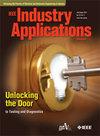Design of Line-Start Permanent Magnet Linear Synchronous Motors With Transient Optimisation
IF 4.2
2区 工程技术
Q2 ENGINEERING, ELECTRICAL & ELECTRONIC
引用次数: 0
Abstract
This paper proposes an optimisation theory to enhance the transient performance of the line-start permanent magnet linear synchronous motor (line-start PMLSM). Constraints are constructed first by addressing the design of the line-start PMLSM. Then a multi-objective description is established to unify the transient responses, including the damping response and the time response, in the line-start process and the transient optimisation strategy is established via particle swarm optimisation (PSO). With different combinations of weighting functions in the multi-objective expression, optimisation cases are analysed and the optimised design of the line-start PMLSM prototype are experimentally tested. The proposed theory is proved to be a feasible and efficient design method of the line-start PMLSM. Three optimal principles of the line-start mover topology are addressed, in which the damping response is addressed to have more impact on the optimal design of the line-start PMLSM compared to the time response. Meanwhile, a larger number of conductive rungs are proved to enhance the performance during the online starting phase. Trends of the combination between permanent magnets and conductive materials are also derived to optimise the damping response and the time results. These optimal principles can be another contribution for the industrial PMLSMs requiring online-starting capability.求助全文
约1分钟内获得全文
求助全文
来源期刊

IEEE Transactions on Industry Applications
工程技术-工程:电子与电气
CiteScore
9.90
自引率
9.10%
发文量
747
审稿时长
3.3 months
期刊介绍:
The scope of the IEEE Transactions on Industry Applications includes all scope items of the IEEE Industry Applications Society, that is, the advancement of the theory and practice of electrical and electronic engineering in the development, design, manufacture, and application of electrical systems, apparatus, devices, and controls to the processes and equipment of industry and commerce; the promotion of safe, reliable, and economic installations; industry leadership in energy conservation and environmental, health, and safety issues; the creation of voluntary engineering standards and recommended practices; and the professional development of its membership.
 求助内容:
求助内容: 应助结果提醒方式:
应助结果提醒方式:


